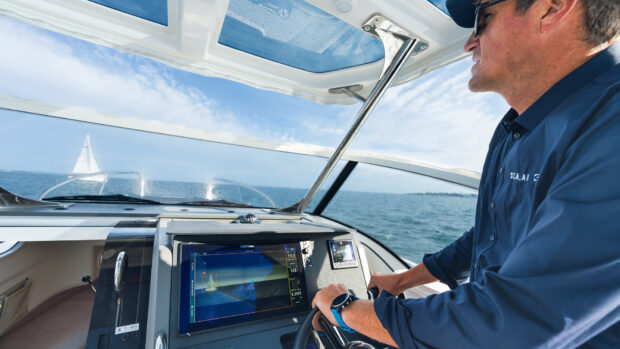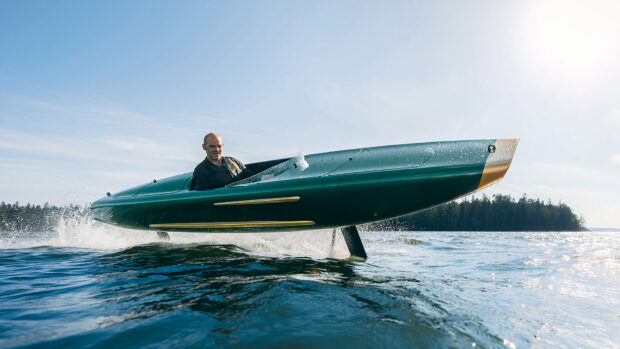Inspired by a 19th century Swedish inventor, Rafnar’s unique arc-of-circle hull forms are truly one of a kind. Dave Marsh reports from Iceland
Scene 2: Rafnar’s changing room
My assertion that I should wear Musto’s snazzy new Arctic Pro jacket, something I’d bought specifically to Iceland to test, is swiftly overruled when a blizzard descends on Reykjavík.
Instead we’re obliged to don bulging survival suits and crash helmets. Looking like a yellow hobbit with attitude, I head out of the harbour on board the prototype 10-metre Leiftur RIB (pictured below), complete with its attractive icing.

The first noticeable trait is that the boat has no perceptible hump whatsoever. With various auto-trim systems now able to help uncooperative pleasure boats on to the plane, that is still a great quality to have in any craft but probably not crucial to leisure boaters simply wanting to go fast all the time.
For any commercial users such as the coastguard, though, it’s a godsend to be able to drive at the precise speed necessary for the manoeuvre in question (e.g. coming alongside a moving vessel) completely unconcerned by the usual irritant of suddenly dropping off the plane, or having to floor the throttles just to regain a smidgen of lost speed.
More leisurely boaters will appreciate this handling characteristic too. Compared with, say, a 10m Scorpion RIB, the 10m Leiftur unquestionably feels more glued to the water.
Still, it is difficult to know exactly what to attribute this to; hull shape, weight or both. Rafnar’s 10m boat weighs around 4 tonnes loaded, compared with the 3 tonnes that, say, a 10m Scorpion would weigh with the same twin 250hp Yamaha outboards and full fuel.
If I designed a 4 tonne 10m RIB, I’d also expect it to feel more planted that a lighter 10m Scorpion. I personally feel this doesn’t matter; the fact is that this unusual hull shape does achieve what its creators are suggesting it does.
As well as feeling firmly planted, the Leiftur proved completely unflappable. Hurling it into full lock turns at the boat’s top speed of around 40 knots did not upset its composure one jot.
Weaving wildly through confused wakes and cornering hard on the top of waves again left it completely unruffled. The hull form may be unique, but it definitely takes good care of its occupants.
I also tested the 12-metre Thorbjorg (pictured below), which looks like a RIB but is actually a conventional boat with a big solid collar. In most ways it behaved like its sibling. Like the Leiftur, it exhibits low running trim and has an unusually small flat wake.

Both generate more spray than a conventional RIB, but this is quickly flattened and never seems to find its way back on board even in windy conditions. However, the prototype Thorbjorg was less refined and developed than its sibling.
With build speed and cost in mind, Rafnar builds its numerous prototypes using glassfibre spray lay-up – the fastest but floppiest form of construction – and that could be felt on board the bigger boat in the form of shimmying as the boat hit the bigger lumps.
And while the exemplary propellers on the 250hp Yamaha outboards felt perfectly tuned to the boat, the props on the huge Konrad sterndrives on the Thorbjorg seemed comparatively vague at times when asked to transmit the 500hp per side into the water.
That limitation wasn’t helped by sterndrive trim controls that weren’t working properly. Trim tabs might have compensated, but curiously, neither boat had any form of interceptor or trim-tab to level the boat in a crosswind.
Okay, we didn’t seem to need them, but given the hull’s nonconformist shapes, it would have been instructive to study the sometimes unpredictable interaction between hull form, loading, crosswinds, trim tabs and engine trim.









